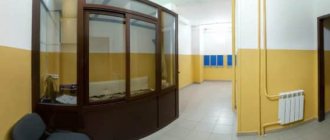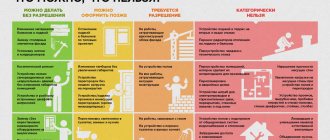The concept of individual heating
Before discussing the advantages of equipment for heating an apartment, you need to find out what autonomous heating of an apartment building is.
This is a special heating scheme for housing, which consists of installing a gas or electric boiler and new engineering systems in a separate apartment instead of old radiators and general heating pipes, which must be dismantled. The newly installed system circulates water, the temperature of which can be increased or decreased depending on the wishes and needs of the resident. Thanks to this, it is easy to establish optimal temperature conditions in the room. This is the simplest explanation for those who do not understand what autonomous heating in an apartment means.
The main difficulties in installing such equipment are due to the fact that the apartment building is already equipped with a common heating system, the owners of which are all apartment owners. Installing individual equipment means making changes to the following:
- belongs to many at the same time;
- is part of a huge utility system owned by large utilities.
To remove even a small part of it and implement changes, which include the individual heating system, you need to do a large amount of engineering work:
- Develop a project.
- Select equipment wisely.
- Install the new system in such a way as not to affect the interests of other residents and not create an emergency situation in the house.
Therefore, the first step is to obtain consent to such changes not only from public utilities, but also from all residents of the apartment building.
Features of individual apartment heating
When planning to switch to autonomous heating, you need to realistically assess your capabilities and understand that most of the options that are quite acceptable for private houses are impossible in a high-rise building. You should immediately “sweep away” solid fuel and liquid fuel boilers of all types.
This is due to the fact that their uninterrupted operation requires a supply of fuel, which is unsafe in an apartment building.
Individual heating in an apartment can be arranged in different ways. There are certainly fewer options than in a private house, but there are enough to choose the system that is most suitable for existing conditions
In addition, it is also extremely inconvenient. In this case, it is also prohibited to use a warm water floor. It is only possible to install one of its electrical varieties.
You need to know that when arranging individual heating in a high-rise building, you will have to take into account not only your own interests, but also the interests of other residents who may be dissatisfied with some of the difficulties arising as a result of your actions.
Therefore, choosing the right heat source is very important. This is an important stage that actually determines the success of the planned event.
Despite the limitations, there are still many options for autonomous systems. First of all, this is gas-fired heating. Moreover, you need to take into account that we are not talking about bottled fuel, but about connecting to the gas main.
The option with cylinders is not even worth considering, since it will cost much more than central heating, and is extremely inconvenient. Heating using mains gas is very economical and can operate completely autonomously.
The best source of heat for one of the apartments in a high-rise building will be a wall-mounted double-circuit boiler with a thermostat and electronic ignition. It will automatically maintain the most comfortable temperature and supply hot water.
If there is enough free space in the apartment, you should pay attention to a boiler with a boiler. This will stabilize the supply of hot water.
Electric heating can also be installed in apartment buildings. It can be implemented in several options, when electricity is used for direct heating, which is more expensive, or indirect.
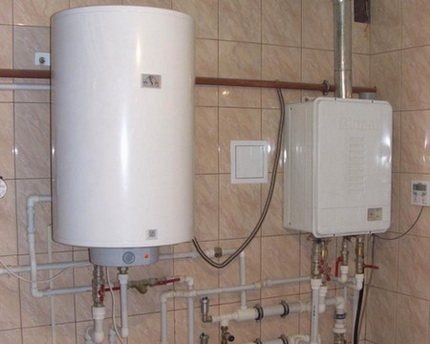
A gas wall-mounted boiler paired with a boiler will, of course, take up quite a lot of space, but this will ensure an uninterrupted supply of hot water at the required temperature and in any volume
A system running on electricity can have a boiler or heat pump as a heat source, and an electric cable floor, infrared film, baseboard radiators or electric convectors as an energy transmitter.
The apartment owner can choose any suitable option or combine several. For example, heated floors and convectors. Let us consider in detail each of the possible methods of arranging autonomous heating.
Advantages and disadvantages of autonomous heating
Individual heating in an apartment building has both advantages and disadvantages. The main advantage of such a system is its controllability by the consumer:
- Independent choice of temperature in the apartment. When it gets cold outside, you can increase the temperature, and if it’s warm outside, lower the temperature or turn off the boiler altogether.
- Saving resources and reducing payments. To heat an apartment, gas or electricity is used in much smaller volumes than in boiler rooms. In addition, with general house heating, some utility companies, even in warm weather in the spring, heat their houses to the maximum in order to increase the amounts in payments. Apartment heating eliminates this possibility.
- The ability to start the system and properly warm up the room if the summer was unusually rainy and cold.
It must be remembered that the ability to choose the temperature yourself depends on the serviceability of the utility network, which is the other side of the coin.
So, individual heating, like any phenomenon, has both pros and cons. The latter include dependence on the serviceability of pipes and other engineering structures.
The main difficulty, which not many people manage to overcome, is the bureaucratization of the process, as well as its high cost. It is often not possible to go through all the stages of coordination, design and obtaining permits, so some people give up halfway.

In what cases is the consent of neighbors not required?

It also happens that the issue can be resolved without a general house meeting. This happens when the heating system in the house and all its elements are not designated by documentation as common property. But even this fact does not mean that independent shutdown will be natural.
In this case, it is necessary to obtain permission from a local organization that provides resource supply services, since during the reconstruction the house registration certificate will need to be edited.
Its third section, in particular, lists detailed information about the heating system. The law regards any change and installation as a technical change that must be included in the technical passport.
The procedure goes better if all residents of the house want to connect individual heating.
Then, at a general vote in the apartment building, an appropriate decision is made, signatures are collected on the consent of all owners and technical documentation is prepared.
Legal regulation
First, you should find out what the law says about whether it is possible to install individual heating in an apartment. The legal acts regulating this issue include:
- . It determines the standards for the reconstruction of premises, the necessary documents, and general issues of housing refurbishment.
- . In Art. 14 mentioned:
- the need to connect to the heat supply system and conclude an agreement;
- cases of impossibility of connection to a common heating system;
- general requirements for how an alternative to central heating is connected in an apartment.
- . This document explains in detail how to determine the technical feasibility of connecting an object, how it is carried out, how project documentation is drawn up, and so on.
When discussing what the legislation requires in 2020, it is impossible not to mention.
This document lists the criteria for choosing a heat supply organization, the method of submitting documents and concluding an agreement with it. And most importantly, it contains a list of energy sources (boilers) that cannot be used for autonomous heating. Other types of equipment not included in this list are allowed for use.
Sequencing
So, your apartment is very cold in winter and you are tired of paying for a service that is not actually provided. Be sure to document this fact by submitting appropriate applications to the heat energy supplier and the sanitary and epidemiological station. Such recording may subsequently play a role in obtaining a refusal and in court proceedings, should the case come to him.

For reference. In the countries of the post-Soviet space, there are many legislative acts on this topic, often contradicting each other. Because of this, the question of whether it is possible to install individual heating in an apartment often has to be resolved in court.
If you follow the right path, then the procedure should be as follows:
- carrying out measures to formalize the refusal of centralized heating services and dismantling old systems;
- obtaining permission to install an individual heat source from the relevant authorities;
- choice of energy carrier for heating the apartment;
- development of technical documentation. In simple words, you need to complete a heating project with a diagram for connecting the heat source to centralized utility networks;
- coordinating it with the energy supplier and obtaining permission to install a heat generator;
- installation work on the heating system.
In practice, the greatest difficulty is passing through the first 2 stages. The heat supply organization may prevent you from refusing services, citing various legislative acts. The same story may repeat itself with obtaining permission to renovate residential premises. You may have to enlist the help of a lawyer and even go to court. The intricacies of these issues should be studied on the appropriate Internet resources.
For reference. In Ukraine, the installation of individual heating in an apartment building is prohibited by the relevant decree; in the Russian Federation there is no direct prohibition, but there are a lot of restrictions in various regulatory documents that cause discrepancies.
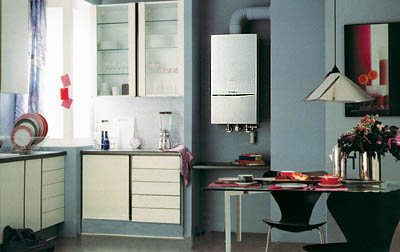
Documentation of an autonomous heating system
In order to obtain permission for individual heating in an apartment, you need to collect the documents listed in Art. 26 of the Housing Code of the Russian Federation:
- An application indicating the address of the apartment in which the redevelopment will be carried out, the signatures of all interested parties, the planned scope of work and other parameters.
- Title documents for housing: sales and purchase agreements, rental agreements, certificate of ownership.
- Residential renovation project.
- Technical passport of the premises.
- Consent of family members, where they will indicate whether it is possible to install autonomous heating in the apartment.
- Conclusion of the authority for the protection of architectural monuments on the admissibility of redevelopment if the house is a protected cultural object.
You need to submit documents to the local administration or the MFC.
Often these authorities refuse to register redevelopment, citing the project’s non-compliance with the law or incomplete information in the documents. However, you need to understand that the reason for the refusal is that:
- None of the officials will take responsibility for authorizing the redevelopment, because mistakes made can lead to the disrepair of the apartment building.
- It is extremely unprofitable for utility authorities to allow the transition to autonomous heating, since this will lead to a reduction in payments.
In this case, you will have to defend your rights in court.
Where to begin
Let's start with the legal framework. It is necessary to clearly know what the legislation says about disconnecting from the central heating system and installing an individual one. Often the local administration, referring to Art. 190 Federal Law , refuses to residents. In court, such a refusal will be considered unfounded. In Russian legislation, in addition to Federal Law No. 190 “On Heat Supply,” there is Government Decree No. 307 of April 16, 2012, which considers the procedure for connecting heat supply systems. It specifies a list of individual sources of thermal energy that do not meet certain requirements and are for this reason prohibited for installation in apartment buildings.
This means that the law does not prohibit the use of individual heating using modern heating boilers that meet the specified requirements.
This issue has been considered more than once by courts of general jurisdiction. Refusal of local governments based on Art. 14 of the Federal Law “On Heat Supply” is declared illegal.
Required documents
Thus, in order to refuse the central heating service and switch to individual heating, it is necessary to collect a package of documents in accordance with Art. 26 of the Housing Code of the Russian Federation on the reconstruction of residential premises.
The package of documents includes:
- application for reorganization;
- technical passport of the premises;
- title documents for housing (originals or copies certified by a notary);
- residential renovation project,
- consent of all family members, submitted in writing;
- conclusion of the authorities for the protection of architectural monuments on the possibility of reconstructing the premises.
Documentation for gas heating
The management company, after reviewing the application, provides a letter of permission to disconnect your apartment from central heating. This letter is necessary to order technical conditions (TU) for the installation of individual heating. If you plan to connect gas (install a gas boiler), you must contact the gas service.
Technical conditions are issued within ten days. In case of refusal due to lack of “technical possibility”, keep in mind that such a response is only permissible in regions where there is no gas and it is not possible to purchase it in cylinders.
After purchasing a certified boiler, you should contact the design organization. She will prepare a project for installing a boiler, taking into account technical conditions and capabilities.
Then a project is made to disconnect from central heating in the heat supply organization. The basis for this will be a letter from the HOA with permission to disconnect. It is important to receive a written response. In case of disagreement, it will be possible to go to court.
Having received the project documentation, we go with it to the local branch of the All-Russian Voluntary Firefighting Society (VDPO). There you will be given a fire safety certificate for the project. If necessary, a design is made for the chimney.
Then all documentation is approved by the administration. The conclusion on approval (or refusal) is accepted within 45 calendar days. Refusal to renovate the premises occurs on the basis of Art. 27 of the Housing Code of the Russian Federation (case of failure to submit all documents). The refusal can also be appealed in court.
This is the basic diagram of how to prepare a project and legalize the transition to autonomous heating. The list of all documents may differ in different regions. More accurate information will be given to you directly from the administration of your district.
How much does it cost to connect?
How much individual heating in an apartment costs is one of the main aspects of the coming changes. In all likelihood, this is what you should start from, because if the tenant does not have a significant amount, you should not even begin such a complex procedure.
There are three main stages of spending:
- Development of a redevelopment project, which includes payment for consultations, certificates from the BTI, legalization, and so on. At this stage, the tenant will spend from 50,000 rubles.
- Purchase of necessary equipment: boiler, pipes, box and combs, valves and other things. Their cost depends on the power of the equipment, material, diameter and length of the pipes. One boiler costs 20,000–60,000 rubles.
- Installation of equipment. The cost of installation will be 30,000–60,000 rubles.
During the redevelopment process, additional expenses will certainly arise, and the final cost will reach 150,000–180,000 rubles.
Stages of installing autonomous heating
By analyzing the provisions of the regulations mentioned above, you can find the answer to the question of how to install individual heating in an apartment. To do this you need to go through the following stages:
- Submit an application for redevelopment to the management company.
- Receive a letter from the management company allowing you to disconnect the apartment from the network.
- Order technical specifications for individual heating. If the boiler is gas, contact the gas service. The received refusal can be appealed in court (does not apply to regions where there is no possibility of connecting to the gas system).
- Before installing individual heating in an apartment building, order a project based on the technical specifications.
- Obtain a fire safety report for the project from the Ministry of Emergency Situations.
- Coordinate all documents with urban planning and architecture authorities.
If, despite the presence of the listed documents, the applicant still receives a refusal, it will have to be appealed in court.
How many approvals do you need to collect?
For individual heating, the apartment needs to be redesigned. Both the destruction of walls and partitions and their construction consist of a labor-intensive process.
It will take a long time to receive each completed paper. It is necessary to take into account installation work and the purchase of materials, so reconstruction begins with the preparatory stages:
- determined with the collection of a documentary package;
- develop a project;
- purchase equipment;
- install an autonomous system.
What legislation regulates individual heating in an apartment building? The regulation for any redevelopment is the Housing Code of the Russian Federation, Article 26.
The reconstruction of residential premises is carried out according to technical requirements; each stage of work must be agreed with the local government. To contact the regional authority, you need to collect documents that will serve as an appendix to the main application.
General documentary support for the submitted application, filled out according to the standard form:
- title documentation - this can be a certificate of ownership, transfer of an apartment by inheritance, a purchase and sale agreement;
- photocopy of technical passport;
- redevelopment of an apartment in the project;
- information about all registered persons in the residential area;
- written notarial consent of each registered person;
- confirmation that the building is not an architectural monument.
When the administration receives a documentary kit, they issue a receipt of its receipt with a detailed list.
The papers will be sent to the commission for approval, the body will review and make a decision within a month. The document will be sent to the applicant for review.
Redevelopment may be refused if it worsens the condition of the house or threatens the safety of residents.
Project documentation for autonomous heating is coordinated with authorized organizations from the field of gas and heat supply.
To disconnect the heating circuit in an apartment from the general system, you need to obtain permission from the city or regional heating networks.
Specialists of this level will agree to an agreement provided that the installations do not disrupt the functionality of the building's utilities and equipment.
Only a security threat can lead to the refusal of a request for heating autonomy. Applications for an individual heating system are accepted by the housing management organization.
Actions consist of the following steps:
- receive a consent letter;
- contact the gas service;
- receive technical specifications;
- take apartment property documents;
- order a project;
- purchase equipment that meets the specifications.
SNiP41-01-2003 contains the basic requirements for heating and ventilation devices. You can be exempt from registration by concluding an agreement with an organization that provides such services.
Selecting a boiler model of the required power
The main advantage of an apartment with autonomous heating is the ability to adjust the temperature. For this you need a suitable boiler. The type of equipment depends on the resource consumed - gas or electricity.

Gas boilers
The disadvantages of this type of equipment include high cost and less safety, because the work process involves open gas combustion.
But these boilers:
- more durable;
- pay for themselves faster;
- significantly more economical due to the lower cost of gas compared to electricity;
- equipped with a special smoke exhaust system;
- do not cause inconvenience to users.
Read more in the article “Gas heating in an apartment.”
Electric boilers
The undoubted advantage of this type of equipment is the lower cost of the boiler itself and its installation. In addition, they are safer to use than gas ones.
However, there are also disadvantages:
- high electricity consumption;
- dependence on electrical networks, which are often worn out and not designed for such power;
- In the event of a power outage, there will be no heating in the apartment.
Selection of pipes and radiators
Before you install autonomous heating in your apartment, you need not only to purchase a boiler, but also to choose the right pipes and radiators.
Pipe parameters are specified in the project, from which you cannot deviate. You can discuss only the details with the organization carrying out the installation: the quality of the material, the installation method, the installation of radiators, and so on.
The final choice of additional equipment and costs depend on:
- power of heating devices;
- pipeline length;
- room area;
- method of wiring the system.
Let's briefly discuss the types of pipes and radiators. Manufacturers produce the following types of pipes:
- Polypropylene. Lightweight, resistant to temperature changes.
- Made from cross-linked polyethylene. Durable, easy to install, lightweight.
- Metal-plastic. They are aesthetically pleasing and easy to install, but are susceptible to sunlight and other aggressive factors.
- Copper. They are the most durable and reliable, but are more expensive than others and are rarely used.
The following types of radiators can be found on sale:
- Aluminum - lightweight, reliable and aesthetic heating devices.
- Bimetallic - strong and durable devices made of two metals (aluminum and steel or aluminum and copper), but more expensive.
- Steel. They are characterized by low inertia, simplicity of design and low cost.
- Cast iron. They are characterized by increased reliability, but low heat transfer.
How to install individual heating
To turn on the heating safely, it must be installed correctly. You can carry out the installation yourself, but it is better to do this at the final and simplest stage - when installing radiators and pipes.
The installation of complex components (boiler, risers, auxiliary equipment) should be entrusted to professionals.
The installed system must be checked for leaks. To do this, it is filled with coolant (water) and started. Detected leaks, which sometimes occur at joints, must be eliminated and the proper operation checked again.
How will the heating fee change?
If you have individual heating, the heating fee will be significantly reduced in comparison with the amounts previously paid using receipts. This is explained by the general logic of charging for heating.
Payment for heating apartments without autonomous heating is based on gigacalories consumed. If there is a meter in the apartment, the calculation is carried out according to the meter readings. If it is not there, based on heat consumption standards established for each region.
Own heating in the apartment makes the principle of operation, and, accordingly, payment completely different.
The apartment is disconnected from the communal heating system and closes on itself. The apartment is heated by heating water that circulates in the pipes. And heating, in turn, is carried out either by burning gas or by electricity (if the boiler is electric). Consequently, utility bills increase either for gas (according to the gas meter readings) or for electricity.
As with residents without autonomous heating, so-called general house needs will be included in their bills.
Regardless of the method of heating the apartment, it is necessary to heat the entrances and maintain utility systems in working order. These needs are divided between residents depending on the area of the occupied apartment.
What does autonomous heating mean?
As a rule, today apartments are equipped with either gas or electric heating equipment. In the first case, the best option is a double-circuit gas boiler, since this way you will not have to pay the housing and communal services for warm water. As for electricity, it is usually used not directly to heat a room, but indirectly, for example, to power a heat pump.
However, no matter what your choice turns out to be, you will always have to take into account the upcoming dismantling of the old heating system, and this is usually very difficult. Just as it will most likely not be possible to save money - you can use the pipes of the old system for new heating only if they are in proper condition, that is, the house is new, or the heating has been recently changed. All this suggests that you are unlikely to be able to install autonomous heating in an apartment with your own hands.
Here you need the help of qualified specialists with extensive experience in this field. And, in general, heating with your own hands is an unconsidered risk since, for example, only a professional with special permission can install and start up gas equipment for the first time.
We recommend: Advantages of autonomous gas heating
So, option number one is gas heating. A modern double-circuit gas boiler with electric ignition, a closed combustion chamber, a programmable thermostat and a built-in safety group is perfect for a city apartment. It is this configuration that allows you to maintain the optimal temperature in the room at any time of the day. But you can also get a large storage boiler - this will also allow you to save on hot water, and install a cheaper single-circuit boiler in your apartment.
Advantages and disadvantages
Since the automation for gas boilers is already manufactured of high quality, usually after starting and setting up, you don’t have to worry about its operation. The provided safety system will eliminate the possibility of gas leaks and minimize other possible risks - with proper operation, of course.
If the apartment is small, then you can choose a completely compact boiler, of lower power, which will not take up much space and will operate almost silently. Moreover, prices for fairly high-quality domestic equipment vary widely. Foreign (European) gas equipment is noticeably more expensive. But both will be enough for many years of work.
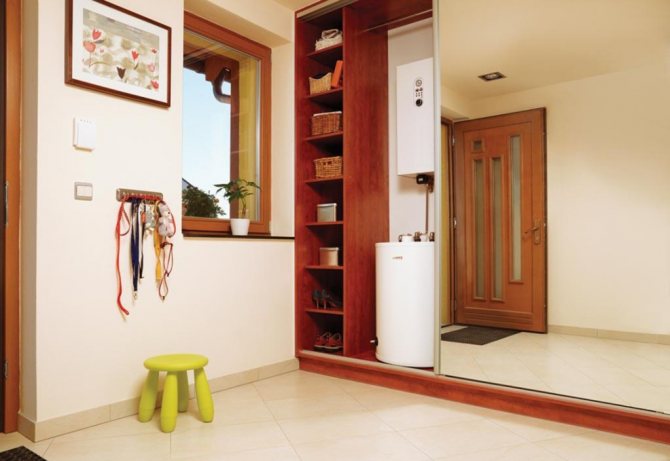
But it must also be said about the disadvantages of autonomous gas heating in an apartment building. The probability of a gas explosion is, of course, minimal, but it still exists. Therefore, when installing a boiler indoors, you should also take care of a good ventilation system. Further. As sad as it may be, the cost of household gas for the population in cities is constantly increasing.
In addition, ventilation requires constant cleaning, since over time it becomes clogged with combustion residues - greasy soot. And if a coaxial chimney is also used, then an unpleasant odor can enter the apartment through an open window. By the way, to install the latter in the facade of the building, the consent of the relevant authorities may also be required.
We recommend: How to make autonomous heating for a garage?
How to make autonomous heating in an apartment: features of the gas system
As a rule, such a heating system is installed in 4 stages:
- installation of a gas boiler;
- the old heating system is turned off and dismantled;
- heating pipes for the new system and radiators are installed;
- gas equipment is connected.
When everything is already installed, you should invite a specialist from the gas service to start the boiler. Only he can ensure that everything meets safety requirements. By the way, in an autonomous heating system in an apartment, water hammer is practically eliminated, and therefore you don’t have to worry about this. This means that you can save a little on the strength of structures: for example, install aluminum radiators and polypropylene pipes reinforced with foil.

However, when installing such a heating system, you should still adhere to a number of rules:
- radiators are connected to the circuit not in series, but in parallel;
- when inserting radiators, a diagonal pattern is used;
- a thermal head is made on the inlet of each radiator;
- a Mayevsky tap is screwed into the top plug of each battery;
- a valve is installed on the radiator supply;
- installation of all batteries is carried out strictly according to the level;
- during tapping, clips-retainers are used to compensate for the expansion of pipes when heated;
- Before starting the system, be sure to perform a pressure test.
In addition, in order for the autonomous heating of the apartment to work reliably and efficiently, it is advisable to include a circulation pump in the system.
YouTube responded with an error: The request cannot be completed because you have exceeded your quota.
- Related Posts
- How to make autonomous heating in a private house?
- Advantages of autonomous gas heating
- What is better, autonomous or individual heating?
- Types of autonomous heating of industrial premises
- How to make autonomous heating for a garage?
- How much does autonomous heating cost?
How to convert an apartment building to individual heating
Converting an apartment building to individual heating is possible. However, the bureaucratic difficulties in this case are even greater than when one apartment is disconnected from the network.
The main problem is that it will be necessary to redevelop many engineering and construction communications of the entire building, and not just a separate part of it. In this regard, the process of obtaining permits becomes very complicated.
If utility networks are recognized as the joint property of the residents of the house, first you need to hold a general meeting at which the residents will discuss whether everyone is willing to install autonomous heating in the apartment building or not.
If the utility system is owned by the municipal authorities, then most likely it will not be possible to obtain permission.
Next you need to proceed according to the scheme given above.
It is worth keeping in mind that the cost of materials, work and projects will be significantly higher, because we are talking about the refurbishment of the entire apartment building.
Obtaining permission for individual heating in an apartment 2020
The procedure for arranging autonomous heating is regulated by the norms of the Housing Code (Articles 26 and 27) and Federal Law No. 190 of July 27, 2010 “On Heat Supply”. In accordance with these documents, in order to install an autonomous heating system in your apartment, you must obtain the consent of local government authorities.
It is issued by an interdepartmental commission responsible for the use of housing stock. A complete package of documents must be submitted to this authority. Authorized employees will study the request, assess the risks of disconnecting a specific apartment from the heating network and make a decision. Officials are given one and a half months to do all this. The final document drawn up by the commission is issued to the applicant within three days after the decision is made.
Preparing documents also takes a lot of time. Its features depend on what type of heating the applicant has chosen - electric or gas.

In the first case, it is enough to write a statement about disconnection from the central heating supply to the city heating networks, coordinate your actions with the administration and submit an application for the installation of an autonomous heating system.
To install a gas boiler, residents must:
- Apply to the gas service.
- Obtain from the fire inspection a document confirming the proper operation of the chimney and ventilation.
- Obtain written consent from neighbors to install autonomous heating.
- Obtain permission from heating networks to draw up and approve a plan for an autonomous heating system.
Now you can begin dismantling the old equipment and installing the new one. The right to connect an individual heat source is granted only to specialists of gas supply organizations. Self-installation poses a threat to life, and neighbors or regulatory authorities may sue. In total, obtaining permits and installation takes from three to six months.
